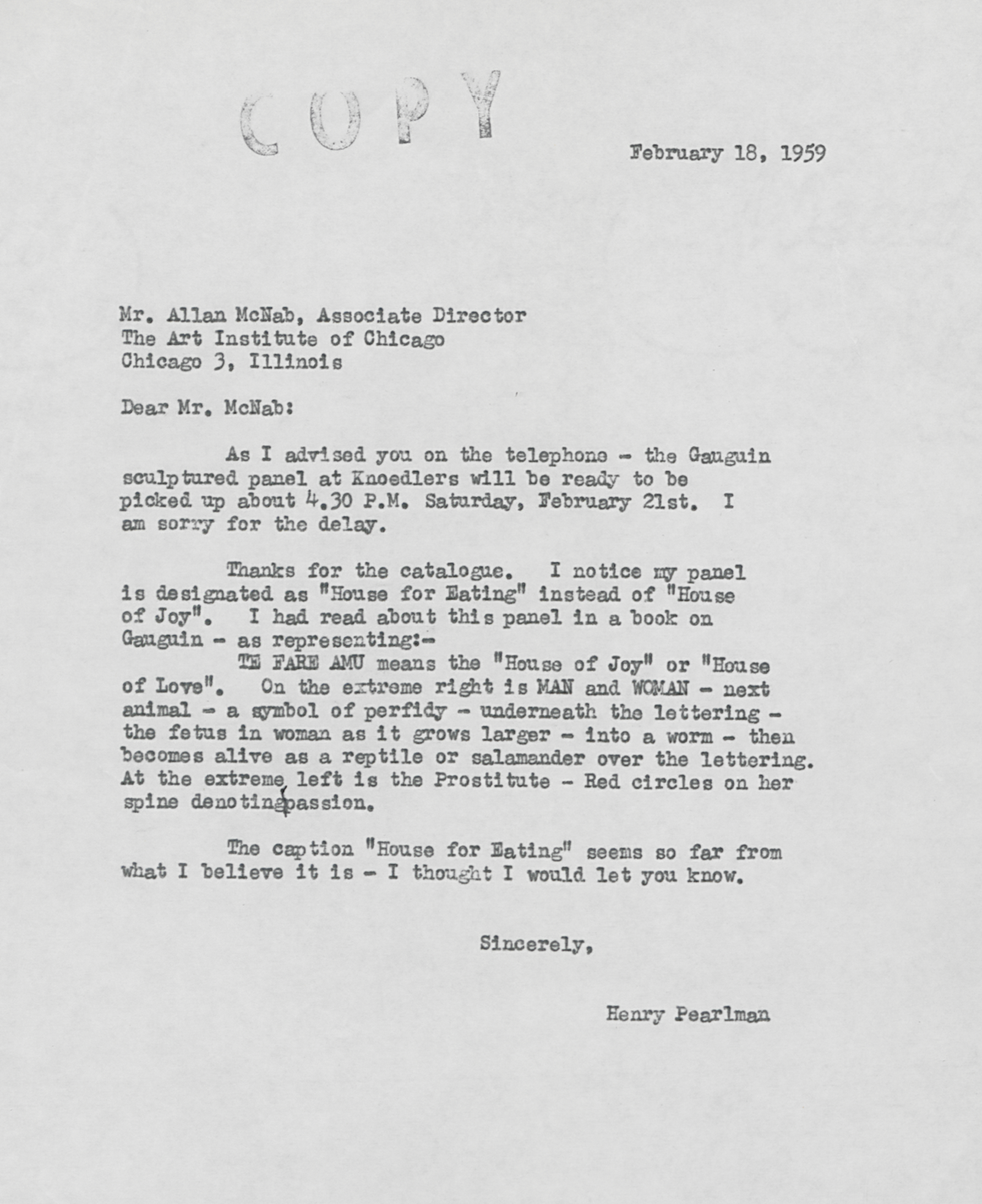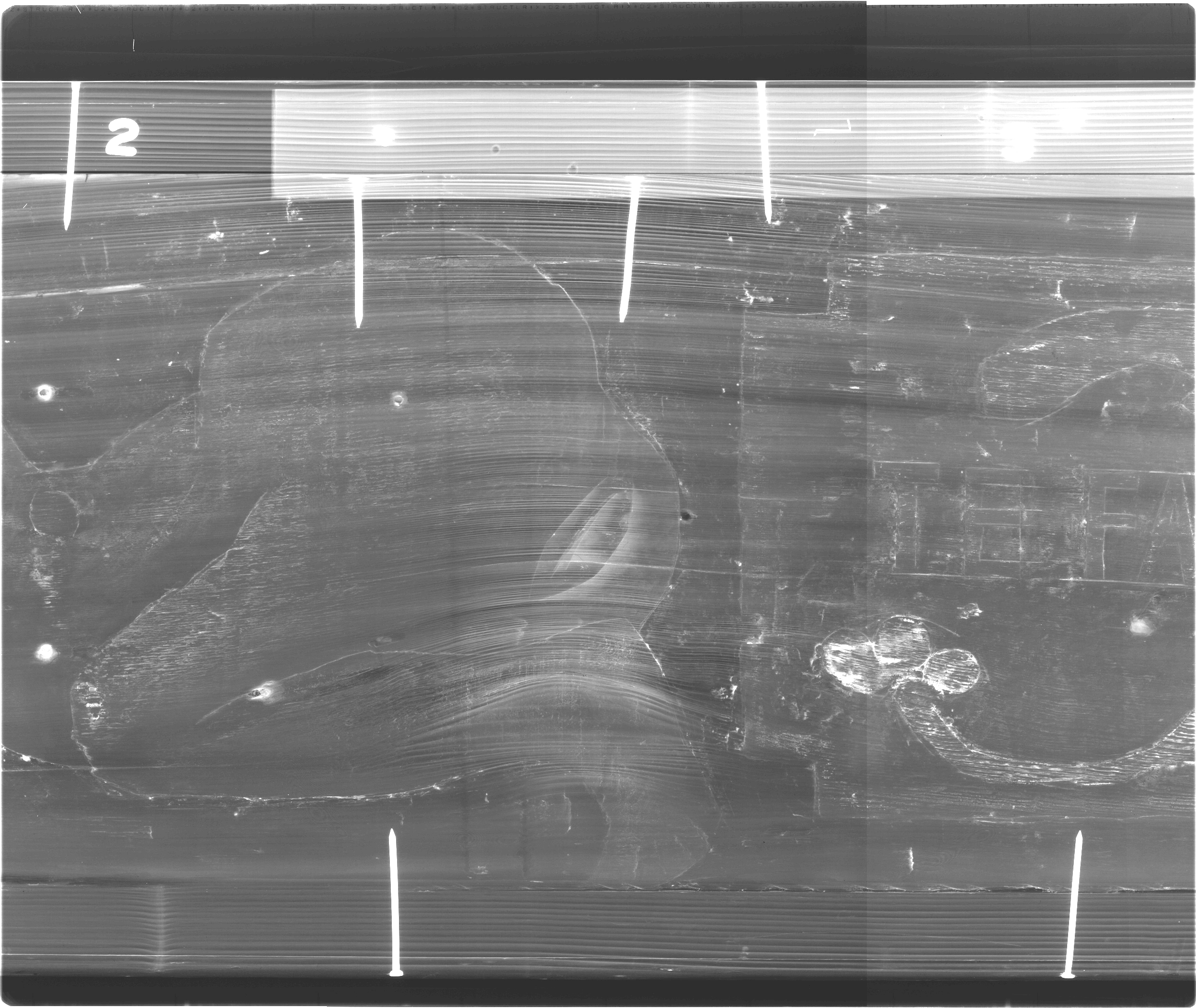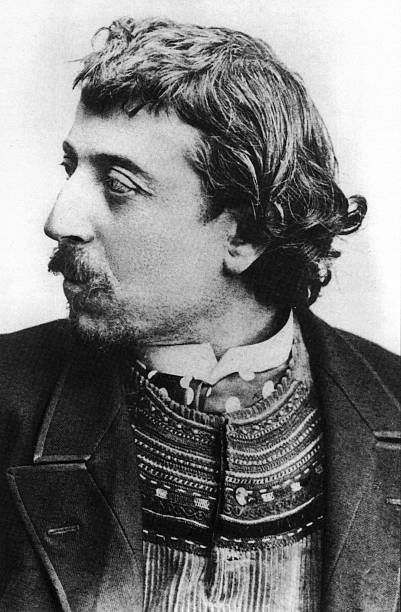


Polychrome woodcarving (sequoia)
24.8 x 147.7 cm. (9 3/4 x 58 1/8 in.)
frame: 45.1 × 167 × 10.5 cm (17 3/4 × 65 3/4 × 4 1/8 in.)
L.1988.62.62
Carved in center: TE FARE AMU PGO
Émile Schuffenecker (1851–1934); Amédée Schuffenecker (1854–1935), Paris, by 1928; by descent to Émile’s daughter, Jeanne Schuffenecker (1882–), Paris. [Katia Granoff (1895–1989), Paris, by 1949]. [Galerie Zak, Paris]; sold to Henry Pearlman, by 21 Oct. 1955; Henry and Rose Pearlman Foundation, 1983.
Gauguin moved to Polynesia in 1895, seeking a simpler life, and never returned to France. Upon his arrival in Tahiti he had a house and studio constructed in the traditional Oceanic manner, with a separate structure for cooking and eating meals – although it is not known whether this “House for Eating” decorated that room or another.
Gauguin carved this work in a style meant to suggest his vision of a “primal” Tahitian culture. The man with red hair may represent Gauguin (although the artist’s hair was dark), while the seductively posed woman at the left has been identified as a prostitute. The wood of this carving has recently been identified as sequoia.

Along with the red circles “denoting passion” that Henry Pearlman mentions in this letter, the prostitute’s genitals were originally painted as well. This x-ray of the work shows the original red that, some time later, was covered with green to match the surrounding skin.

On one visit to Paris, I saw a sculptured and painted wood panel by Gauguin in a large well-known gallery on the Left Bank. It was quite sensual, and I figured it would not be…
On one visit to Paris, I saw a sculptured and painted wood panel by Gauguin in a large well-known gallery on the Left Bank. It was quite sensual, and I figured it would not be easily accepted by the American public. I passed it over, bur during the following year I kept thinking of it, and resolved that the next time I got to Paris I would look at it again. On my next trip, I went to the gallery, and not seeing any sign of it around – and knowing the dealer well enough nor to show too much interest in it – I inquired whether she owned a Gauguin cane. She said no, but did mention the panel I was after, and after daily visits over three or four days, we finally concluded a deal. But that was only the beginning. First, I had to gain the permission of the Louvre to take the work out of the country. Then I had to pass it through U.S. Customs, which could have refused admission on account of its indecency. Third, there was the question of where to hang it once I had overcome the first two obstacles. One way or another I overcame these hurdles, and the panel arrived at my New York office.
Reading through books on Gauguin, I found that the words on the panel, “TE FARE AMU,” meant “House of Joy” in the Tahitian language. The right side of the panel depicts a man and a woman together with an animal nearby that represents perfidy. The center, beneath the words, shows a fetus as it grows into a worm and then a tadpole. On the left side of the panel is the image of a prostitute, with her genitals exposed and red buttons running up her spine denoting passion.
The panel was hung over the entrance door to Gauguin’s hut in the Marquesas Islands; in addition, he had carved two nudes, one on each side of the door. In the last two years of Gauguin’s life, he had not only gone native, but had assumed the role of protector of the natives. It seems that a missionary bishop was trying to civilize the natives by forcing them to wear shoes, go to church regularly, and observe marriage vows and ceremonies. Gauguin had many arguments with the bishop, and after a final falling out, he made the panels and hung them about his entrance door, and the bishop never entered his house again.

Paul Gauguin (1848-1903)
Gauguin was fascinated by the idea of exotic cultures, seeing in them a purer way of life and an aesthetic that challenged the hegemony of Western art. One of the leading Post-Impressionists, Gauguin went beyond the depiction of the outward experience of modern life in order to represent inner visions and eternal symbols, abandoning the art world of Paris to explore such far-flung locales as Tahiti. Gauguin’s use of startlingly vibrant color combinations and flat passages of paint, together with his quest for alternatives to the European status quo, had an enormous effect on future generations of avant-garde artists, including many abstract painters.
Gauguin was born in Paris and spent part of his childhood in Lima, Peru, where he had maternal relatives. After returning to France, in his early adulthood he worked briefly as a stockbroker before abandoning his position to pursue art. In 1874 he studied with Camille Pissarro in Paris, immersing himself in the new forms of Impressionist painting. After many peripatetic years spent struggling to both produce works of art and support his family, in 1886 the nearly destitute Gauguin moved to the village of Pont-Aven in Brittany. Inspired by the verdant countryside and local customs, he created increasingly inventive stylized paintings and clay sculptures. Seeking to escape European strictures, Gauguin traveled to Panama and then Martinique, where he found inspiration in the lush tropical lifestyle. He returned to France after only few months, yet continued to integrate allusions to non-western cultures into his work.
Hoping to find an Edenic paradise where he could thrive creatively, in 1891 Gauguin set sail for Tahiti. When he arrived, he was disappointed to find that traditional island life had been incontrovertibly corrupted by colonialism. Nevertheless, he created paintings, sculptures, and woodcuts inspired by his idealized views of Polynesian life, combining them with religious imagery and other personal symbols and myths. After returning to France from 1893 to 1895, Gauguin again traveled to Polynesia. He attempted to live as a self-styled “savage” in Tahiti and the Marquesas Islands, notoriously taking up with very young local women and adorning his wooden huts with primitivizing woodcarvings, such as Te Fare Amu. In addition to creating artwork, Gauguin wrote about his experiences in Polynesia, most notably in his book Noa Noa. After suffering from syphilis and conflicts with colonial authorities, Gauguin died in 1903 in the Marquesas. His influence continued to grow, however, as evidenced in artistic movements such as Expressionism and Fauvism.